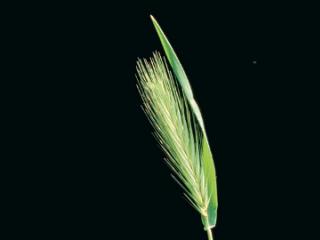Identification and attributes
Latin names - Hordeum glaucum and Hordeum leporinum
In Western Australia, H. glaucum is referred to as northern barley grass.
Distinguishing features
Both H. glaucum and H. leporinum have very prominent auricles and a membranous ligule and their leaves are 1.5–2mm wide and up to 20cm long. They are sparsely covered with soft hairs and taper to a point. Leaves tend to be a paler green colour than other common annual grasses. Barley grass grows to about 45cm in height.
The inflorescence is a cylindrical spike-like panicle that is often partly enclosed by the sheath of the flag leaf. The spikelet is made up of three florets, the central one being fertile, the lateral ones usually sterile. Glumes and awns are rough and sharp. When they are ripe the spikelets fall off the plant as units. Barley grass can be confused with other grasses such as brome grass (Bromus spp.), wild oats (Avena spp.) and volunteer cereals in early stages of development. A few simple identifying features can be used to help distinguish barley grass from other grass species in the early stages of growth. These are:
- Seeds germinate rapidly after the autumn break
- Seed remnants are often still attached to the roots after germination, frequently with the characteristic multiple awns clearly visible
- Leaf colour tends to be a lighter green than other species such as great brome (Bromus diandrus), which tends to be a darker green with a dull purplish tinge
- Leaves tend to be quite twisted in growth and the leaf tips often show signs of frost damage
- Auricles are present.
Disadvantages and benefits of barley grass
Barley grass is an annual species renowned for rapidly germinating in autumn to provide valuable stock feed soon after breaking rain.

The rapid germination of the species after rainfall also gives barley grass the potential to act as a ‘green bridge’ for cereal root rot diseases. It is a major host of the disease take-all, with yield losses up to 80% possible under ideal conditions. Barley grasses harbour scald and net blotch of barley and also host a type of stripe rust.
The seed is a problem in pasture, hay and silage, causing eye injuries to sheep, reduced live weight gains and reduction in wool quality. It can be carried on animals and fabric and is a common contaminant of hay and feed grains.
Post-emergent herbicide control is limited in cereals due to a limited range of herbicides available for the control of barley grass in wheat and other cereals.
Biology
Barley grass will germinate at a wide range of temperatures (7–32°C) although its optimum range is 10–15°C. The seeds germinate more rapidly in response to autumn rain than other grasses (such as Lolium spp.) and are able to establish before the soil surface dries out. It has low levels of hard seed and most of the seed formed in the spring will germinate in the following autumn. Since a very high proportion of barley grass will germinate on the autumn break, it is unusual for further significant germinations during the year.
Herbicide resistance
In Western Australia, there are barley grass populations that have developed resistance to Group B - SUs (for example, sulfometuron, sulfosulfuron). There have been reports in other states of barley grass being resistant to paraquat and diquat and to several Group A ‘fop’ herbicides. Some populations have cross resistance to the Group A ‘dim’ herbicides.


